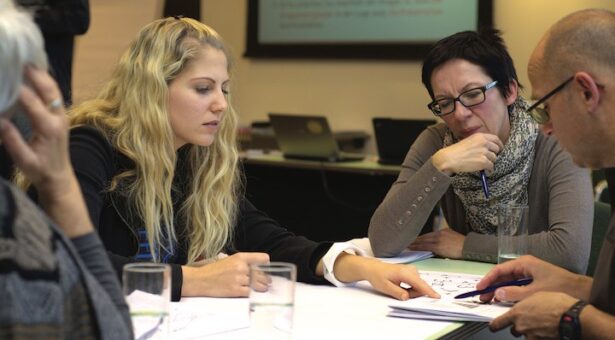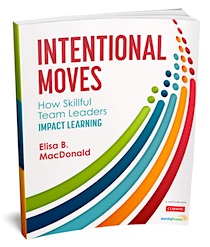Team Leaders Use Clear Parameters to Build Trust
Elisa MacDonald is a nationally recognized expert in establishing effective teacher and school leadership teams. Her latest book is co-published by Corwin and Learning Forward.
By Elisa B. MacDonald

I make tough decisions about which photos to include. I carefully choose backgrounds that fit best with each month. I sequence pages to tell a chronological narrative of our year. This labor of love is truly labor. But each January 1st when I hang the calendar on the wall, I’m so happy I’ve done it.
This year my 13-year-old daughter asked if she could make the calendar. The “mom lightbulb” went off in my head:
A good mom sees this as an opportunity to challenge her daughter’s artistic talent and feel proud when the extended family learns she made their calendar this year.
A well-intentioned busy mom in a time crunch sees giving this task to her daughter as one less thing that mom has to do!
And so I uploaded 150+ photos, showed her how to use the tools on the photo platform, and said, “Go to it! I trust you.”
After hours of work, my daughter showed me what she created and I began to panic. Christmas photos in March?! Snowy pics in July?! Ten photos of the dog and none of grandma?! The “leadership lightbulb” went off in my head:
A good leader would take time to explain the parameters of the project, show the daughter past calendars, and explain the intentional design choices for each page
A well-intentioned leader who is under a time crunch and really wants an amazing calendar will wait until the daughter goes off to school and redo the pages.
That fragile thing called Trust
I have worked with and been a member of school teams where leaders “trust” teams to do important collaborative work, but once the work is underway, they make significant changes to what teachers did.
Team members feel like, “What was the point of spending all of our time on that?” And leaders feel like, “This didn’t meet expectations. I have to change it.” Although the product might turn out okay, trust between the leader and the team is strained.
In my professional consulting work, I often share moves that can help teacher leaders, coaches and administrators lead teams toward having a greater impact on educator and student learning. I include multiple strategies that nurture a culture of trust, set clear direction, and help teams focus and make clear decisions. What follows is a brief synopsis of one move that would have helped me in the situation with my daughter.
The Move:
Framing Conversations
with Clear Parameters
Whether you are a principal facilitating a change initiative or a teacher leader facilitating a content-level team, set clear parameters with adult learners upfront, so that neither goals, nor people’s hard work, nor trust is compromised. Here’s how:
►Articulate purpose. Learners need to know the big picture reason for collaboration. How does this conversation/task fit in with your team’s priorities? Sample sentence frame: “The task we will do today connects to our school goal in the following ways…”
►State the intended outcomes for collaboration. Learners are more productive and focused when they have a clear sense of the desired result for the conversation. Sentence frame: “We are looking to leave this meeting with… (name a deliverable.)”
Image by 14995841 from Pixabay
►Clarify how people should (and shouldn’t) engage. If you’ve ever heard someone say, “I’m not sure if I should bring this up here…” then you know that parameters have not been clearly understood. Offer clear guidelines on ways to participate in the conversation. Sentence frame: “For this conversation, we will need to refrain from… because we want to be able to…”
►Model or provide examples. Just like an effective teacher in the classroom, skillful team leaders model expectations for collaboration when possible. Sample sentence frame: “I’ll demonstrate one approach and the thinking behind my choices…”
►Clearly articulate roles and decision-making. If Dante were looking for a tenth circle of hell, I would propose “ambiguity.” Learners need to understand the decision-making process and their role in it. Studies show that if someone perceives the process as flawed, then they will have less ownership in the decision, which will negatively affect their desire to implement it. (Baggozzi et al., 2003). Sample sentence frame: “This decision will be made by…. My role is…. Your role is….”
(Note: A leader can opt to set and communicate parameters to the team, or the leader can choose to set parameters together, with the team. The key is that everyone has a shared understanding of the parameters before engaging in a team task or conversation.)
The Framing Move in Action
Example #1
The following example shows an instructional coach framing clear parameters for their school instructional leadership team.
Instructional Coach: We are aiming for consistency of expectations and feedback to students in non-fiction writing across grade levels. Today we are going to generate specific indicators on our whole school writing rubric. We’ll focus on the “meets expectations” category today, but no other column. I input an example of an indicator in the pre-writing phase: “Student articulates purpose for writing through some form of preferred expression.”
I include this because setting purpose is a key component for good writing, and yet some students can’t yet articulate it in words but can do so orally or in drawing. We will work on this together, but please know that our work today will be submitted to the district literacy coordinator who is working with a teacher leadership team across schools to generate a universal rubric. Our contributions today will shape what is produced but may not look exactly as we have written it in the final version.
Example #2
The following example shows a team leader framing clear parameters for their content-grade level team.
Team Leader: We are tasked with analyzing student data to ultimately address student misconceptions. For this 15-minute opening conversation we are going to only make observations about the student errors on the math homework, but we are not at this time going to share our opinions about why they made these errors, or strategies we tried, or resources we know of. There will be time for that in the second half of today.
For now, we are just looking at students’ errors when finding ratios and unit rate. I’ll start. I noticed that, of those who got the problems wrong, eight students set up double number lines with the correct numbers, but incorrectly labeled them.”
Building a culture of trust
In hindsight, I wish I had framed clear parameters upfront with my daughter. Fortunately, a teenage girl will not hold back in telling a mother what mom did wrong, and they can work it out. But our colleagues might not be as forthcoming with us. Be intentional about naming the parameters for collaboration about any task with your team so that you can reach better outcomes together. Doing so is more than being a good communicator; it’s building a culture of trust.
Reference
Bagozzi, R., Dholakia, U., & Basuroy, S. (2003). How effortful decisions get enacted: The motivating role of decision processes, desires, and anticipated emotions. Journal of Behavioral Decision Making, 16, 273–295. https://doi.org/10.1002/ bdm.446
Read another MiddleWeb article by Elisa MacDonald:
Leadership Tips for Summer Collaboration
Read our review of
Elisa MacDonald’s latest book Intentional Moves:
“Team Leader Moves That Impact Adult Learning”
Elisa B. MacDonald is an educator and leadership consultant with nearly thirty years teaching, coaching, and leading with schools and organizations. Her latest book, Intentional Moves: How Skillful Team Leaders Impact Learning (Corwin/Learning Forward, Aug. 2022) is the definitive guide to leading school teams toward desired student-learning outcomes.
She is also the author of the bestselling The Skillful Team Leader: A Resource for Overcoming Hurdles to Professional Learning for Student Achievement.
View her upcoming virtual workshops and courses at www.elisamacdonald.com. Follow her on social media platforms @elisaBmacdonald.





































